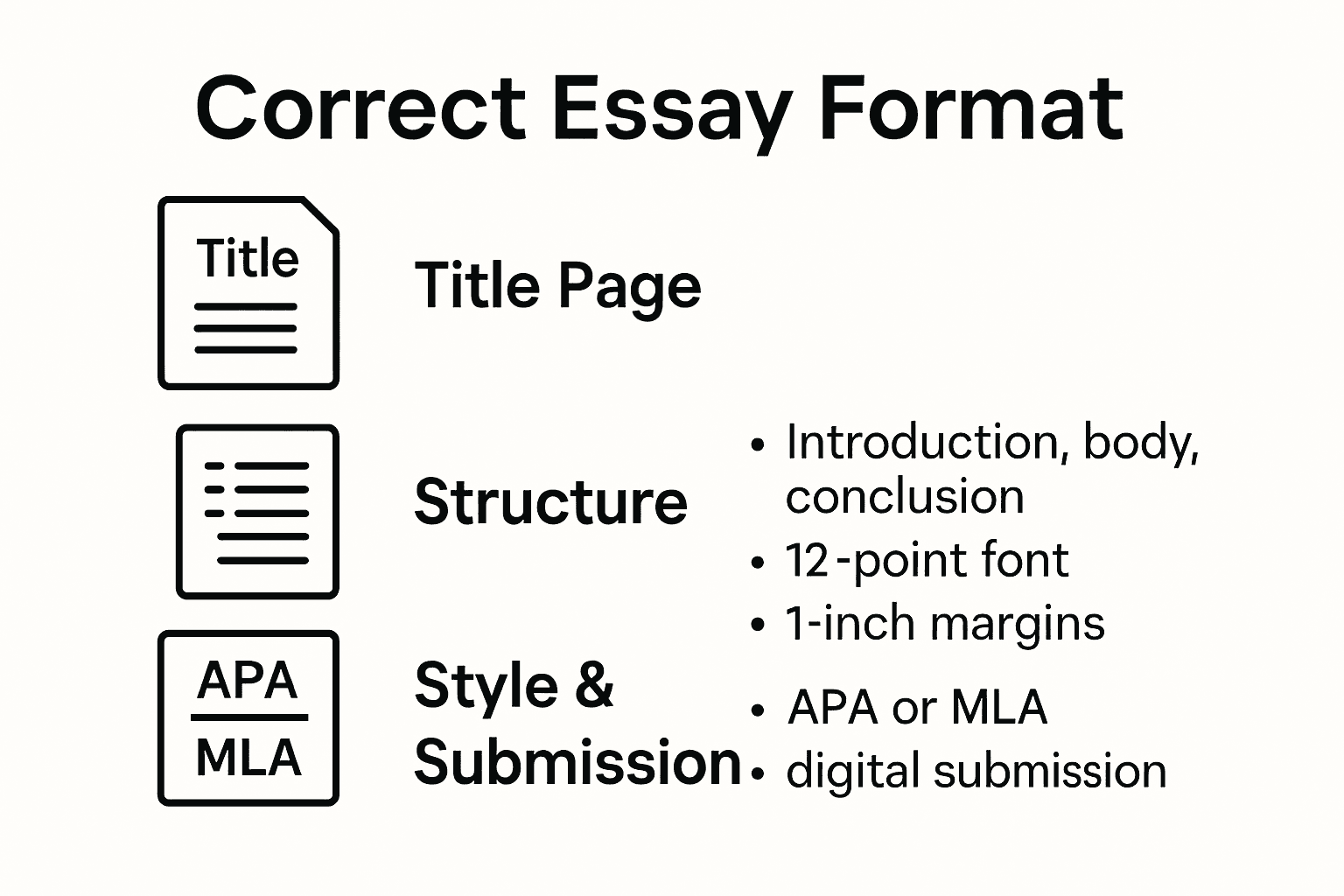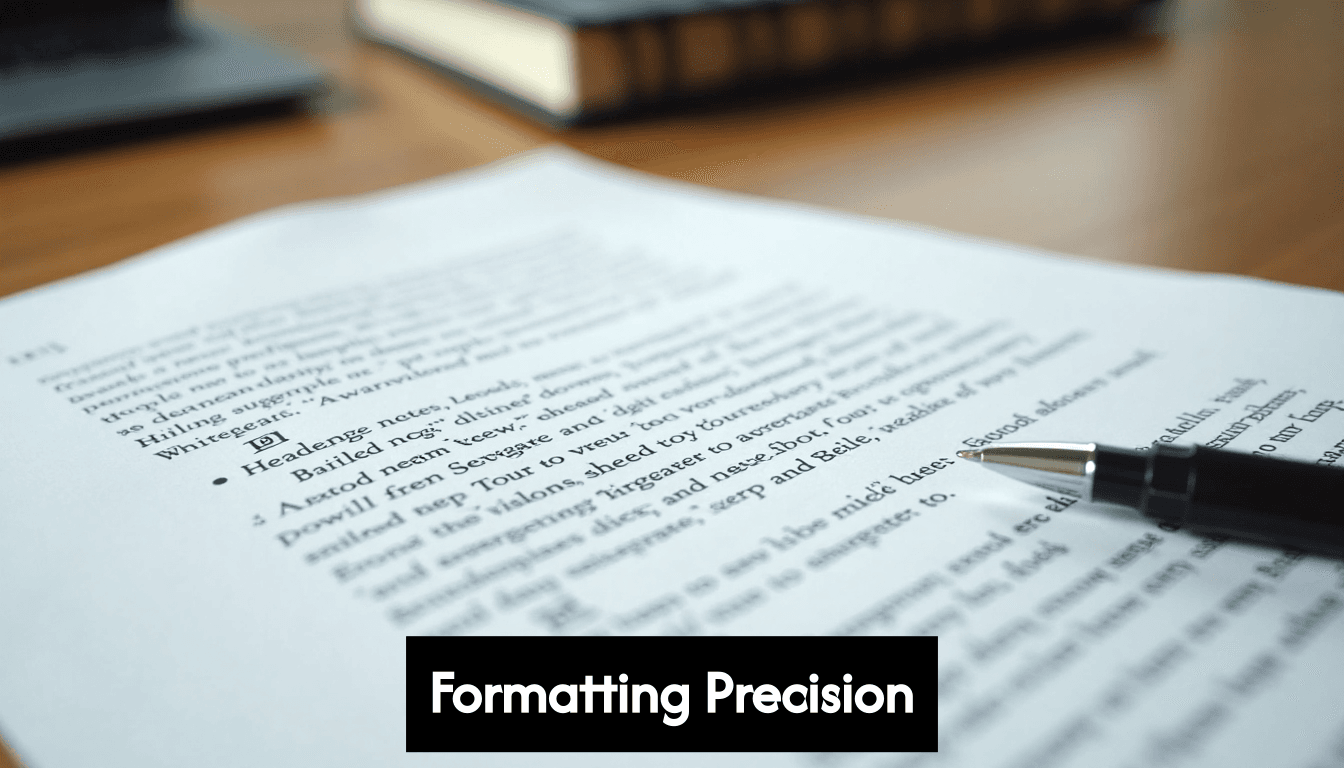Blog
Learning Materials
The Correct Essay Format Guide for 2025: Tips for Students & Educators
Updated: June 16, 2025

Essay formatting can look simple on the surface. Students think a few settings are all it takes, but wait. Inconsistent formatting is one of the top reasons essays get rejected by academic competitions and professors—costing students thousands in lost scholarships and opportunities. The twist? The right format does more than keep you out of trouble. It makes your argument stand out before a single word of content is read. Get ready to see what most people miss about the power of essay presentation.
Table of Contents
- Core Components Of Academic Essay Structure
- Navigating Citation And Referencing Standards
- Digital Submission And Modern Formatting Considerations
Quick Summary
| Takeaway | Explanation |
|---|---|
| Understand Core Components | Familiarize with the essential elements like title page, organization, and structure for a coherent essay format. |
| Follow Citation Standards | Adhere strictly to specific citation styles (APA, MLA, Chicago) for in-text references and bibliographies to ensure academic integrity. |
| Avoid Common Formatting Mistakes | Double-check submission requirements, eliminate typographical errors, and maintain consistent formatting to enhance professionalism. |
| Master Document Organization | Employ a clear outline to structure your essay logically, ensuring smooth transitions and a comprehensive intellectual journey. |
| Enhance Visual Presentation | Use consistent typography, strategic spacing, and clear headings to improve readability and create a polished academic document. |
Understanding the Basics of Correct Essay Format
Navigating the academic writing landscape requires a solid understanding of correct essay format. In 2025, students and educators must recognize that proper formatting is more than just aesthetic precision—it's a critical communication tool that demonstrates academic professionalism and ensures clear, standardized presentation of ideas.

Core Components of Academic Essay Structure
A correct essay format begins with fundamental structural elements that create a coherent and professional document. These core components include a consistent title page, precise page layout, and strategic organization of content. According to essay composition guidelines, students should pay careful attention to several key formatting aspects.
The title page represents the first impression of your academic work. It typically requires specific information: the essay title, your name, institutional affiliation, course details, and submission date. Font selection plays a crucial role—most academic standards recommend Times New Roman, size 12, with 1.5 line spacing. This standardization ensures readability and maintains a professional appearance across different academic documents.
Navigating Citation and Referencing Standards
Citation is a critical element of correct essay format. Different academic disciplines utilize specific citation styles like APA, MLA, or Chicago, each with unique formatting requirements. Academic research competitions emphasize the importance of consistent and accurate citations, which demonstrate scholarly integrity and provide proper attribution to original sources.
When preparing an essay, students must carefully follow the prescribed citation style. This includes formatting in-text references, creating a comprehensive bibliography, and maintaining consistent punctuation and capitalization rules. Proper citation not only prevents plagiarism but also allows readers to trace and verify the sources of your research.
Digital Submission and Modern Formatting Considerations
With the evolution of academic writing, digital submission has become increasingly prevalent. Many institutions and competitions now require essays in specific digital formats like PDF or Word documents. Contemporary essay guidelines recommend maintaining anonymity by removing personal identifiers from the document itself, facilitating blind review processes.
Modern essay format also considers word count parameters. Most academic submissions specify a range—typically between 1,500 to 3,000 words—excluding footnotes and supplementary graphics. Understanding these technical specifications is crucial for students aiming to meet academic standards.
For students seeking additional insights into crafting the perfect essay, our comprehensive guide to essay formats offers in-depth strategies and practical tips to elevate your academic writing.
Key Components: Structure, Font, and Citations
Crafting a professional academic essay requires a meticulous approach to its fundamental components. While content remains king, the structural and technical elements of an essay play a crucial role in communicating academic excellence and ensuring clear communication.
Standardized Essay Structure
A well-organized essay follows a systematic structure that guides readers through the intellectual journey. According to academic writing standards, the standard essay typically comprises several key sections: title page, abstract, table of contents, introduction, body paragraphs, conclusion, and bibliography. Each section serves a specific purpose in presenting and supporting the central argument.
The introduction sets the stage by presenting the thesis statement and providing context. Body paragraphs develop arguments systematically, with each paragraph focusing on a distinct point that supports the overall thesis. The conclusion synthesizes the key arguments and reinforces the central message, leaving a lasting impression on the reader.
Typography and Formatting Precision

Font selection and formatting are not mere aesthetic choices but critical elements of academic communication. International academic guidelines recommend specific typographic standards to ensure readability and professionalism. Times New Roman in size 11 or 12, with 1.5 line spacing, remains the gold standard for most academic submissions.
Margin requirements are equally important. Standard academic formatting typically demands 1-inch margins on all sides, creating a clean and consistent visual layout. Page numbers should be placed in the top right corner, and headers often include the student's last name or essay title to maintain document organization.
Citation and Referencing Protocols
Citation is the backbone of academic integrity. Different disciplines require specific citation styles—APA, MLA, Chicago—each with unique formatting rules. Academic citation research emphasizes the importance of consistent and accurate referencing to credit original sources and prevent plagiarism.
In-text citations must follow the prescribed style guide precisely. This includes proper formatting of parenthetical references, quotation marks, and bibliographic entries. Researchers must track all sources meticulously, ensuring that every reference is accurately represented in both in-text citations and the final bibliography.
For students seeking deeper insights into mastering academic citation techniques, our comprehensive guide offers detailed strategies to navigate the complex world of scholarly referencing.
Remember, a well-structured essay with impeccable formatting demonstrates not just academic knowledge, but also professional discipline and attention to detail.
Common Mistakes to Avoid in Essay Formatting
Essay formatting might seem straightforward, but numerous subtle errors can undermine an otherwise excellent academic document. Understanding and avoiding these common pitfalls is crucial for students and researchers aiming to present professional, polished work.
Overlooking Submission Requirements
One of the most frequent formatting mistakes occurs before the writing even begins. Academic competition guidelines reveal that students often fail to carefully review and follow specific submission instructions. These requirements can include precise page limits, mandatory information placement, and document formatting specifications.
For instance, many academic submissions require specific details on the first page: full name, essay category, chosen prompt, and institutional affiliation. Omitting these critical elements can result in immediate disqualification or reduced assessment scores. Students must meticulously cross-reference their document against the original submission guidelines, ensuring every technical requirement is precisely met.
Typography and Layout Errors
Typographical mistakes can significantly impact the professional appearance of an academic essay. Common errors include inconsistent font usage, incorrect spacing, and improper margin settings. International academic standards emphasize the importance of maintaining a consistent and professional document layout.
Particularly problematic are issues like mixing font types, using inconsistent font sizes, or failing to maintain standard 1-inch margins. Some students mistakenly use decorative fonts or vary font sizes within the document, which disrupts readability and appears unprofessional. Consistency is key—stick to recommended fonts like Times New Roman, maintain uniform size (typically 11 or 12 point), and ensure consistent line spacing throughout the document.
Citation and Referencing Mistakes
Citation errors represent a significant formatting challenge for many academic writers. Improper referencing not only undermines academic integrity but can also be interpreted as potential plagiarism. Different citation styles—APA, MLA, Chicago—have specific formatting requirements that must be followed precisely.
Common citation mistakes include inconsistent in-text reference formatting, incorrect bibliography entries, and failure to track sources accurately. Students often struggle with nuanced citation rules, such as handling multiple authors, citing online sources, or formatting block quotes. Our comprehensive guide to academic citations offers detailed strategies to navigate these complex referencing protocols.
For those seeking to elevate their academic writing, our APA formatting resource provides step-by-step guidance on avoiding common citation and formatting pitfalls.
Remember, meticulous attention to formatting details demonstrates not just technical competence, but a commitment to academic excellence and professional communication.
Expert Tips for Perfecting Your Essay Layout
Crafting a professional essay layout requires more than technical precision—it demands a strategic approach that communicates academic rigor and intellectual clarity. Experts consistently emphasize that a well-designed essay layout is a powerful communication tool that can significantly enhance the reader's understanding and engagement.
Strategic Document Organization
A meticulously structured essay begins with comprehensive planning. Academic writing standards recommend developing a clear architectural approach to document organization. This means creating a logical progression that guides readers seamlessly through your intellectual argument.
Start by developing a comprehensive outline that maps out each section's purpose and relationship. The introduction should provide context and present the thesis, body paragraphs must develop distinct yet interconnected arguments, and the conclusion should synthesize key points while offering broader insights. Transitions between sections are critical—they should feel natural and create a smooth intellectual journey.
Precision in Visual Presentation
Visual presentation goes beyond mere aesthetics. International academic guidelines stress the importance of consistent, professional formatting that enhances readability. This includes strategic use of white space, consistent paragraph indentation, and careful heading hierarchies.
Typographic choices matter significantly. While Times New Roman remains standard, pay attention to subtle details like line spacing, paragraph alignment, and header formatting. Left-align your text with a 1.5 line spacing, use consistent font sizes for headings and body text, and ensure clear visual separation between sections. These seemingly minor details collectively create a polished, professional document.
Advanced Formatting Strategies
Advanced essay layout involves more than following basic rules. It requires understanding how visual design can enhance cognitive comprehension. Competition submission guidelines recommend implementing nuanced formatting techniques that improve document clarity and reader engagement.
Consider using subtle visual cues like consistent heading styles, strategic paragraph breaks, and judicious use of block quotes to break up text. Ensure your document maintains a clean, professional appearance by avoiding excessive formatting or decorative elements. Each visual choice should serve a clear communicative purpose.
For students seeking comprehensive guidance, our ultimate writing format guide provides detailed strategies for transforming technical formatting into an art form.
Remember, an exceptional essay layout is not just about following rules—it's about creating a clear, engaging pathway that invites readers into your intellectual exploration.
Frequently Asked Questions
What are the core components of correct essay format?
The core components include a consistent title page, precise page layout, and strategic organization of content. Critical elements also involve adhering to citation styles and maintaining professional typography throughout the essay.
How do I choose the right citation style for my essay?
The right citation style typically depends on your academic discipline. Common formats include APA for social sciences, MLA for humanities, and Chicago for history and some social sciences. Always consult your institution’s guidelines for specific requirements.
What common mistakes should I avoid in essay formatting?
Common mistakes include overlooking submission requirements, inconsistent typography, and citation errors. It is essential to review formatting guidelines carefully and ensure consistent use of fonts, margins, and citation formats.
How important is visual presentation in essay formatting?
Visual presentation is crucial as it enhances readability and helps convey professionalism. Utilizing consistent typography, strategic spacing, clear headings, and well-organized layout significantly improves the overall quality and impact of an essay.
Ready to Eliminate Formatting Stress? Let AI Power Your Next Essay
Struggling with citation rules, submission guidelines, and time-consuming formatting tweaks? You are not alone. Many students miss out on academic opportunities because of small formatting mistakes like inconsistent font sizes, missed bibliography entries, or overlooked digital submission rules. You already know from our guide how misunderstood essay formatting can cost scholarships and academic recognition. Why let tiny errors hold you back?

Let Samwell.ai handle the details for you. Our AI-driven platform instantly applies the correct academic structure, perfects each reference in APA or MLA, and even catches common citation mistakes before you submit. Use features like the Power Editor for fast content improvement or try Guided Essays to streamline your next outline. Make every submission stand out for its excellence. Sign up today and ensure your next essay passes every formatting test with confidence.
Recommended Articles
- 2025 Ultimate Guide: Types of Essay Formats Explained
- Mastering Informative Essay Format: A Step-by-Step Guide
Generate essays with Samwell.ai
Whether you’re a publisher, professor, journalist, or student, let us tailor a plan just for you.Most Read Articles

Your Guide to Help Writing a Essay Successfully
Expert tips for help writing a essay - from crafting a thesis to structuring your essay effectively.

How to Write Critical Thinking Essay: Expert Tips
Expert tips for writing a critical thinking essay. Learn how to structure, choose topics, and use evidence effectively.'

How to Write a Good Hook: A Step-by-Step Guide
Master the art of crafting a good hook with our guide. Create compelling openers for a memorable first impression.

